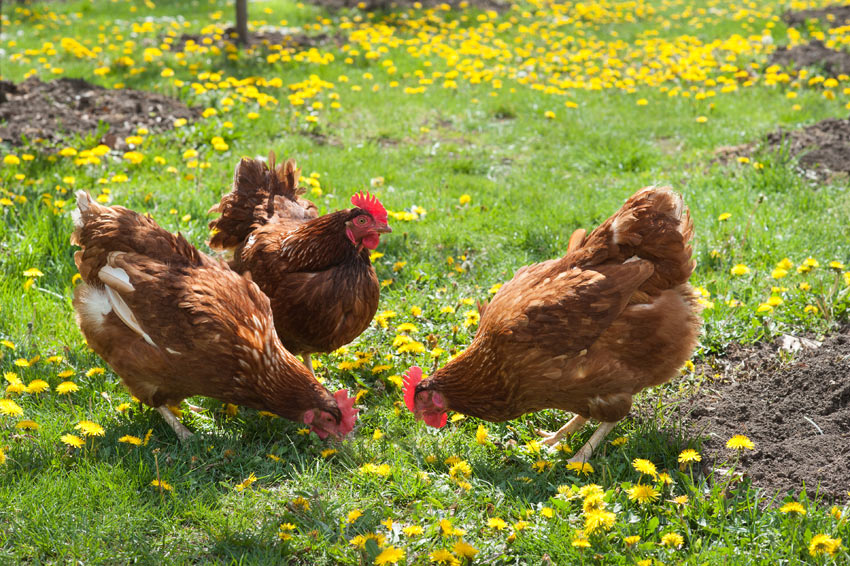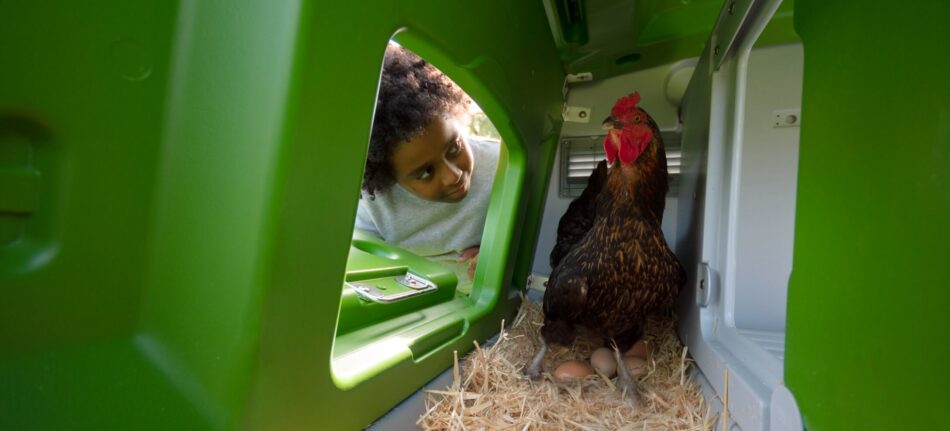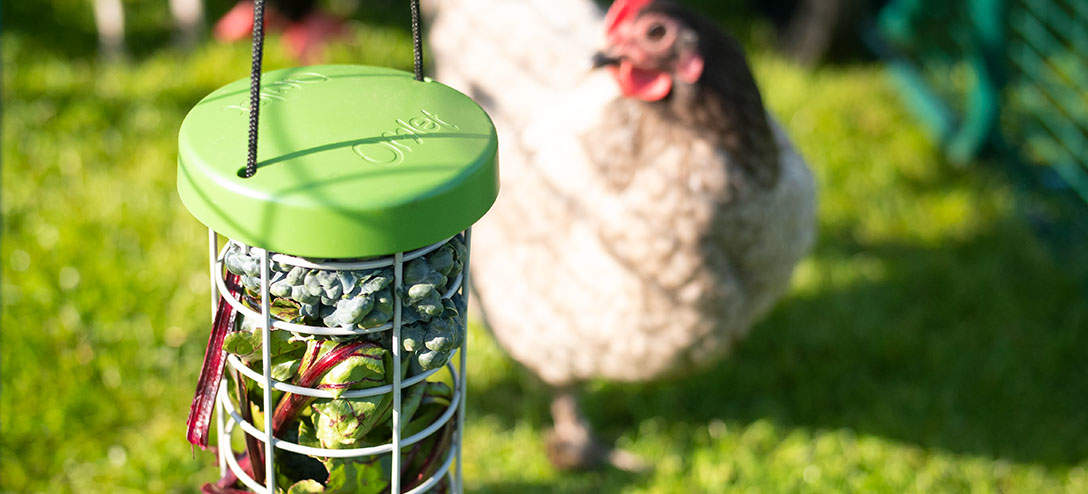Why spring is the perfect time to get chickens
Spring is the perfect time of year to set up a chicken coop and bring home new hens. As your garden begins to stir from its winter slumber, your chickens will benefit from the first fresh greens that become available – essential to your hens’ diets. As well as this, the warmer and longer days mean that your chickens will start producing more eggs again after the winter lull. Plus, raising chickens in the gentler climate of the season also means that you’ll have a happier and livelier flock.

Table of Contents
When should I buy point of lay chickens?
Have you ever heard of the term ‘spring chicken’? Well, it actually stems from its literal meaning when in the early 1700s, farmers realised that chickens born in spring were being bought at better prices than those who had already been through their first winter. Most breeders now hatch eggs in December and January, so spring is the time of the year when point of lay, or ‘spring chickens’, become available.
A point of lay chicken is a hen approximately between 16 and 22 weeks old that is just about to begin laying its first eggs, hence ‘point of lay’. This is a good time to get hens, as they are old enough to take care of themselves but happy to be moved and introduced to a new home. When point of lay occurs, however, can vary somewhat between breeds and other external circumstances. For example, larger hens such as Orpingtons will not reach their point of lay potentially until they are 26 weeks old. For further information on when your hens will begin laying, have a read of our previous blog.
How long will spring chickens produce eggs for?
Having fresh delicious eggs is one of the main reasons why many chicken keepers decide to keep hens to begin with. Therefore, choosing the right time of year to get chickens is something to consider to ensure that you have a frequent supply of eggs for as long as possible.
Chickens will stop laying when they are around six years old, with egg production becoming more infrequent as your hen gets older. Bringing hens home during spring when your chickens are at the very beginning of their laying lives will give you at least three years of dependable egg production. To give your hens a helping hand with their egg supply, you should supplement their diet with plenty of calcium to strengthen the quality of their eggs. An egg shell improver is a perfect way to get this essential mineral in for your flock.
Spring means happy, healthy chickens
Now, this isn’t to say that your chickens will be unhappy should you get them during any other season that isn’t spring- far from it in fact. If you prepare accordingly for more extreme weather that other seasons bring, your flock can flourish any time of the year.
However, spring makes raising chickens that little bit easier. The season follows on from a cold winter when your flock would have had less grass to peck at and have spent more time cooped up as opposed to out in their runs or running free-range. Furthermore, the wintertime means that just like us, some chickens with a weak constitution can be more vulnerable to illness, whilst in summer your flock needs that extra bit of help to stay cool. The spring climate on the other hand is just right! This being said, there are also some other advantages to getting chickens during winter, autumn, and summer, which we’ll discuss later in the blog.
Red mite control
Something to be aware of as a prospective chicken keeper when getting hens in spring is red mite. Red mites can be a problem in chicken coops but fortunately, their numbers drop drastically in the winter. Early spring, therefore, is a good time to spray your chicken coop and run against these tiny blood-sucking creatures before the warmer weather causes a population boom.
Red mites love traditional wooden coops, with plenty of nooks and crannies for them to get into. Should you run into a problem with red mites in your coop, a suitable mite spray should do the job. However, an even better year-round preventative action is to give your spring chickens a coop that is practically mite-free. Keeping chickens in a state-of-the-art plastic chicken coop such as the Eglu Cube gives these pests nowhere to hide. Since the Omlet Eglu chicken coops can easily be washed in a few simple steps, red mites don’t stand a chance!
While you’re zapping the red mites, spring is also the best time of year to treat hens for parasitic worms. You should also continue to give them their regular chicken general health check during this season. Again, there are relatively few of these parasites in the environment at the end of winter, so treating the chickens now is a great preventative measure.
Hatching chicks in spring
Now we’ve established that spring is the perfect time of year to get point of lay hens, can the same be said about buying baby chicks, or even hatching them yourself? Deciding whether you should get/hatch baby chicks over choosing a slightly older point of lay pullet is dependent on what your priorities are as a chicken keeper.
As we discovered, should you opt to get a point of lay hen over this season, then they’ll of course be ready to start laying during the spring and summer when we have the most daylight. This is something to bear in mind as if you hatch/buy a baby chick in spring, you could be waiting six months before they’ll produce their first egg. For example, if you hatch an egg in April, it might not be until October when they begin egg laying, and with fewer daylight hours, chickens produce fewer eggs.
This being said, spring is still a very popular time to get baby chicks for many chicken keepers. Other than how utterly adorable they are, raising chicks is also an incredibly rewarding process, watching them grow up from the very beginning. More specifically why spring is a great time to raise chicks is because you have the advantage of warmer, but not too hot, weather. When your chicks have reached four to five weeks, they can be moved permanently to their outdoor chicken run, so your young chicks can enjoy plenty of time having fun in the sunshine that winter chicks would miss out on until they’re older.
If you decide that you would like to hatch chicks, Omlet has a wide range of supplies and guides to help you along your journey. Have a read of our step-by-step guide to hatching chicks blog for some tips on where to begin.
Expanding your flock with new breeds in spring
If you’ve been chicken-keeping for a while now and considering introducing a few new birds to your flock, then spring is the ideal season to expand. Should you expand your flock with purebred chickens, they will generally only lay between spring and autumn, making this season the perfect time to maximise egg laying for the year ahead.
Whilst general advice says to keep your flock the same breed, this doesn’t necessarily have to be the case. A range of chicken breeds can live in harmony, what’s more important is that they are of a similar age and size. Furthermore, having an understanding of the personalities of your existing flock and the traits of the breeds you plan on introducing is something else to consider, to ensure they don’t clash.
Summer chickens
If you’re rehousing barn hens as opposed to point of lay chickens, summer is a great time to do so. Whilst rehomed barn hens will enjoy all that spring has to offer, they also enjoy a bit more sun where they can live happily as newly-liberated chickens! Ex-barn hens (and ex-battery hens too, in parts of the world where batteries are still allowed) make great pets. In spite of having been ‘retired’ by their former owners, they will have up to two years of good laying left.
Another advantage of getting chickens in summer is that if you let your hens free range in the garden during this time, they will pick off pests such as slugs and flies. However, just be mindful that as chickens are very partial to tender young plants, you may want to protect young shoots and flower beds.
If you do opt to get any chicken, be it rehomed hens or baby chicks, during this time of year, you need to be sure to keep them protected from any extreme temperatures. The hot weather, therefore, is one potential drawback of getting chickens in summer as opposed to in the spring. If you live in an area that experiences particularly hot summers, make sure your birds have plenty of shade and a well-ventilated coop. Fortunately, the Omlet Eglu chicken coops are perfect for keeping your flock cool and with an Eglu coop weather protection shield, you’ll be able to provide a shaded environment for your chickens all day long. Take a look at our guide to keeping happy, healthy hens in summer for a bit more guidance on keeping chickens over this season.
Autumn and winter chickens
Autumn is another great season for chickens and chicken keepers. There are lots of juicy bugs to scratch for in the still-soft ground and leaf litter, and if you have any fruit trees, there are rich pickings for the birds in the shape of windfalls.
Hens often moult in the autumn, so they need a good diet to help them stay healthy and grow new feathers. Extra chicken vitamins and minerals will support them, and a little apple cider vinegar in their water will aid in ensuring they maintain a healthy, glossy new plumage.
Most chickens don’t mind the colder temperatures of winter at all. However, they do prefer not to get wet, so it’s a good idea to provide a bit of extra protection with a cover for the coop. Unless you live in a particularly cold climate, your chickens will rarely get too chilly. They are hardy birds (with the exception of some of the more delicate, decorative breeds), and will adapt to the climate. Nonetheless, it’s always a good idea to assist them wherever you can. The Omlet Eglu extreme temperature protection range is great for harsher winters, offering that extra level of insulation for your flock. An insulated chicken coop such as the Eglu Cube will also go a long way towards ensuring your birds’ health and happiness in the winter months.
Something else to note over this season is that your run will get a bit muddy! A top tip to prevent this as much as you can is to cover the ground with bark chippings.
Omlet and your flock
Spring is an ideal time to introduce new hens to your garden but with Omlet products, we can support your chicken-keeping journey at any point of the year. With the right care and equipment like our innovative chicken coops, chicken runs and coop weather protection, your flock can thrive in any season!
This entry was posted in Chickens


